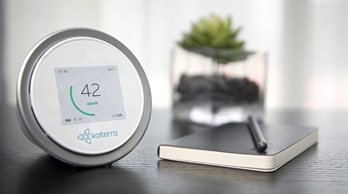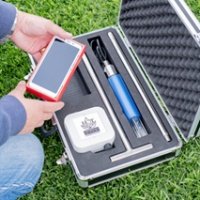How Is Overall Indoor Air Quality Measured?

What Is Air Quality?
Air quality is the sum of several characteristics that can affect a person's health and wellbeing. This article discusses how overall air quality is measured and highlights typical product examples, including notable features and applications.
How Is Overall Air Quality Measured?
Overall air quality is measured using an Air Quality Index (AQI). An AQI is an accepted overall air quality determination tool used by government agencies to communicate the current and forecasted public health risk of polluted air. In short, as the AQI increases, so too does the risk to public health.
What is an Air Quality Index?
While air quality indices vary between countries, the methodology used to determine an AQI always involves monitoring a particular group of air pollutants over a given time. The six pollutants measured by the US AQI are:
- Ozone
- Particulate matter (PM10 and PM5)
- Carbon monoxide
- Nitrogen dioxide
- Sulphur dioxide; and
- Lead.
The maximum concentration values and averaging period for these pollutants are available in Appendix 1 (below). Air quality index reports comprise:
- The calculated AQI value
- A colour code
- AQI category – this is the levels of health concern; and
- A health message and advice related to the level of concern.
Table 1 below details the six categories of the US Air Quality Index.
AQI Value |
AQI Color |
AQI Category |
Health Message |
|
0-50 |
Green |
Good |
Air quality is considered satisfactory, and air pollution poses little or no risk. |
|
51-100 |
Yellow |
Moderate |
Air quality is acceptable; however, for some pollutants, there may be a moderate health concern unusually sensitive people. |
|
101-150 |
Orange |
Unhealthy for sensitive groups |
The general public is not likely to be affected at this AQI range. People with lung disease, older adults and children, are at a greater risk. |
|
151-200 |
Red |
Unhealthy |
Most people may begin to experience some adverse health effects, and sensitive groups may experience more severe effects. |
|
201-300 |
Purple |
Very unhealthy |
This category would trigger a health alert signifying that everyone may experience more severe health effects. |
|
301-500 |
Maroon |
Hazardous |
This category would trigger health warnings of emergency conditions. The entire population is more likely to be affected. |
Table 1 The six categories of the US AQI with their value, colour, category and health message. Source: The United States Environmental Protection Agency)
Air Quality Analysers
Air Quality Analysers are excellent tools for the measurement of hyperlocal air quality and individual pollutants concentrations. Your Instrument Choice Scientists have selected two representative examples of air quality analysers they recommend for use at home.

AirLink Air Quality Analyser
|

Laser Egg + CO2 S
|
Conclusion
Air Quality Indexes provide an overall assessment of air quality. For an amazing range of air quality analysers that measure both AQI and individual parameters, suit any budget, parameter and accuracy requirements - browse here.
For more information on air quality analysers, speak with an Instrument Choice Scientist: Call 1300 737 871 or email [email protected].

Appendix 1
|
Pollutant |
Averaging period |
Maximum concentration |
Maximum allowable exceedances (goal) |
|
Carbon monoxide |
8 hours |
9.0 ppm |
1 day per year |
|
Lead |
1 year |
0.50 µg/m3 |
No exceedance |
|
Nitrogen dioxide |
1 hour |
0.12 ppm |
1 day per year |
|
PM10 |
1 day |
50 µg/m3 |
No exceedances (see note) |
|
PM2.5 |
1 day |
25 µg/m3 |
20 µg/m3 (2025 goal) |
|
Photochemical oxidants (as ozone) |
1 hour |
0.10 ppm |
1 day per year |
|
Sulfur dioxide |
1 hour |
0.20 ppm |
1 day per year |
Note 1: Before 2016, there was an allowance of 5 exceedances per year for the PM standards. This standard was replaced in 2016 by an exceptional event rule. An exceptional event is a fire or dust occurrence that adversely affects air quality at a particular location, causing an exceedance of 1-day average standards above normal historical fluctuations and background levels directly related to bushfire, jurisdiction-authorised hazard reduction burning or continental-scale windblown dust. The handling of exceptional events in the reporting of averages is specified in the Air NEPM.
Also interesting
Soil Moisture sensors are a practical, quick and effective tool for monitoring soil moisture content out in the field. This article investigates four types of soil moisture sensors and how they work.

Our team of scientists regularly welcomes inquiries about installing and take care of weather sensors, like rain gauges. Accurate rainfall measurements depend entirely on how you set up and maintain your rain gauge. Because there are some key rain gauge management considerations, we came up with a list of tips and tricks to help you get it right from the get-go.
Whether you need a rain gauge, or you already have one - get this valuable advice here.

